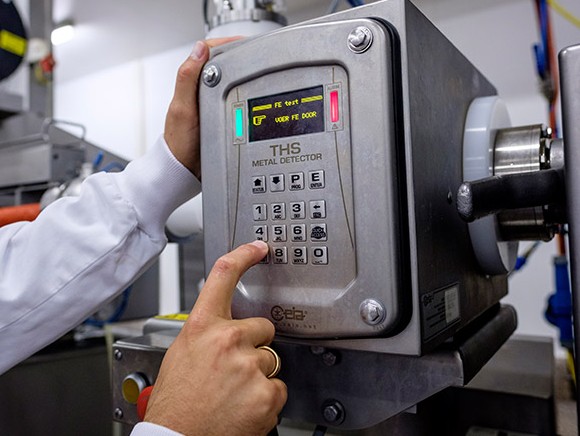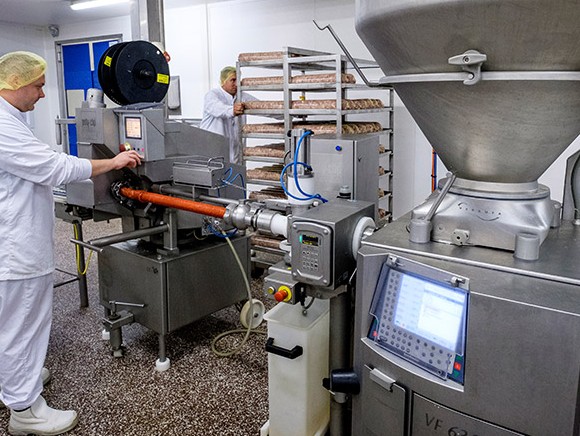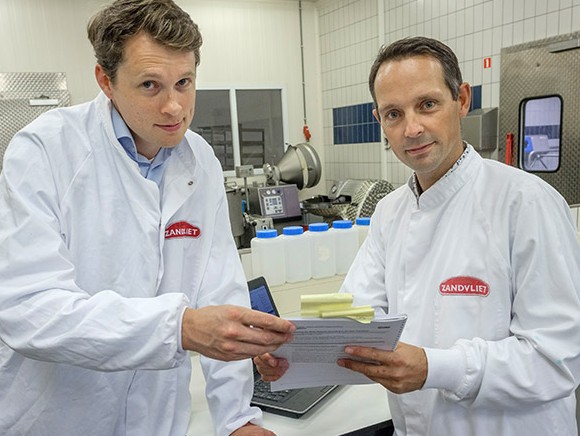
Quality and product innovation are two key pillars for Zandvliet Vleeswaren, a meat producer from the Dutch city of Delft. The family-owned business has a firm focus on the future – not only by responding to the latest developments, but also by continuously looking at what it does well and striving to do it even better. One example is its state-of-the-art metal detection system by the Italian supplier CEIA.
In addition to sliced cooked meats, Zandvliet Vleeswaren also produces meat-based appetisers and meal components such as chicken strips and ham cubes. The company’s specialities are cooked sausage and grilled sausage. “Our company dates back to 1929. All the knowledge has been passed down over the years, resulting in balanced recipes and flavour formulations. We combine that with today’s know-how to make tasty, traditional-style sausage products on an industrial scale,” comments Ben Verhoork, one of the company’s directors.
Nowadays, the company has four different production plants, two of which work with pre-cooked semi-finished products only. “That was a conscious decision,” says Ben. “We wanted to keep the raw meat products well away from the cooked ones for food safety reasons, so the semi-finished products are made in a different facility from where the slicing and packaging takes place. That gives us full control over the entire process from beginning to end, enabling us to keep a tighter grip on quality and to also work to customer-specific requirements – in terms of portion size, shelf life and sliceability, for example. As a result, we can meet our customers’ needs very quickly.”
One of the people helping Zandvliet Vleeswaren to stay on top of the very latest developments is the company’s product developer, Robin Forman, who is responsible for new products in response to market demands. “One project we’ve recently completed was to reduce salt levels. We played a proactive role in establishing the new standards. We’re now transitioning to the Beter Leven (‘Better Life’) quality mark for meat. That’s not always easy in terms of the availability of raw materials, and it’s a big step from the product perspective too.” A unique collaborative project with an industrial designer even resulted in 3D-printed meat and lasered sausages. Ben: “We’re continuously looking at the market proactively. We don’t always need to develop completely new products. Sometimes it’s enough to make improvements and adjustments, such as to the size, shape or ingredients.”
“We have far fewer false positives now”

“We always want the very best,” states Ben firmly. The topic of food safety is no exception, so Robin investigated whether they could do any aspect of the metal detection activities even better. “Metal contamination is never a stand-alone incident,” he says. “It’s often caused by a combination of events – of a bolt breaking off, for example, allowing two metallic parts to wear as a result of friction. All metal detectors will find that bolt, but the slivers of metal that can continue to be produced for a long time afterwards are often much harder to detect.” He read up on the subject in trade journals and visited trade shows to find out more. The Italian supplier CEIA sparked his interest with its multispectrum technology. The family-owned company initially developed this technology to detect the newest generation of land mines, which contain less metal. Whereas a regular metal detector works with just one frequency at a time, multispectrum technology utilises multiple frequencies simultaneously while maintaining maximum sensitivity. This makes it better at detecting smaller particles and at filtering out interference caused by things like minerals or moisture in the ground.
“Multispectrum technology is perfect for the meat industry too, because meat is an organic material product with a high moisture content and varying temperature and composition,” claims Sales Engineer Tim Keizer from Heat and Control, a CEIA partner in the Netherlands. “This presents a challenge to standard metal detectors that have to be set to a lower level of sensitivity, but CEIA’s technology manages to detect contaminants effortlessly.” Robin can testify to this. He regularly tests the metal detector by adding tiny fragments of metal to a test batch of products, and the CEIA machine spots them all every single time. “Not only that,” adds Robin. “We also have fewer false positives plus the very best fail-safe solution. The CEIA detector itself takes care of removing contaminated batches from the process. It maintains control with its integrated ejection system, even if the power supply is interrupted or the compressed air system is deactivated. Last but not least, the detector head is extremely waterproof and its higher protection class ratings (IP66 and IP69K) make it an improvement over other inspection equipment.”

Robin and his colleagues are happy with the CEIA solution and now work with single-frequency and multispectrum metal detectors at various stages of the process. If they have any ideas for improvements, they share them with Tim, who values their input: “That way, at least we know what a customer really needs. They also appreciate the feedback at CEIA, where they are very R&D-driven. We have really short lines of communication with Italy.” Summing up, Robin says: “By providing feedback and suggestions, we push each other to the next level and strive for the very best quality.”
www.zandvliet.com
www.heatandcontrol.com
www.multispectrum.nl
Photo: Sales Engineer Tim Keizer (l) and Product Developer Robin Forman
Source: ©Roel Dijkstra Fotografie